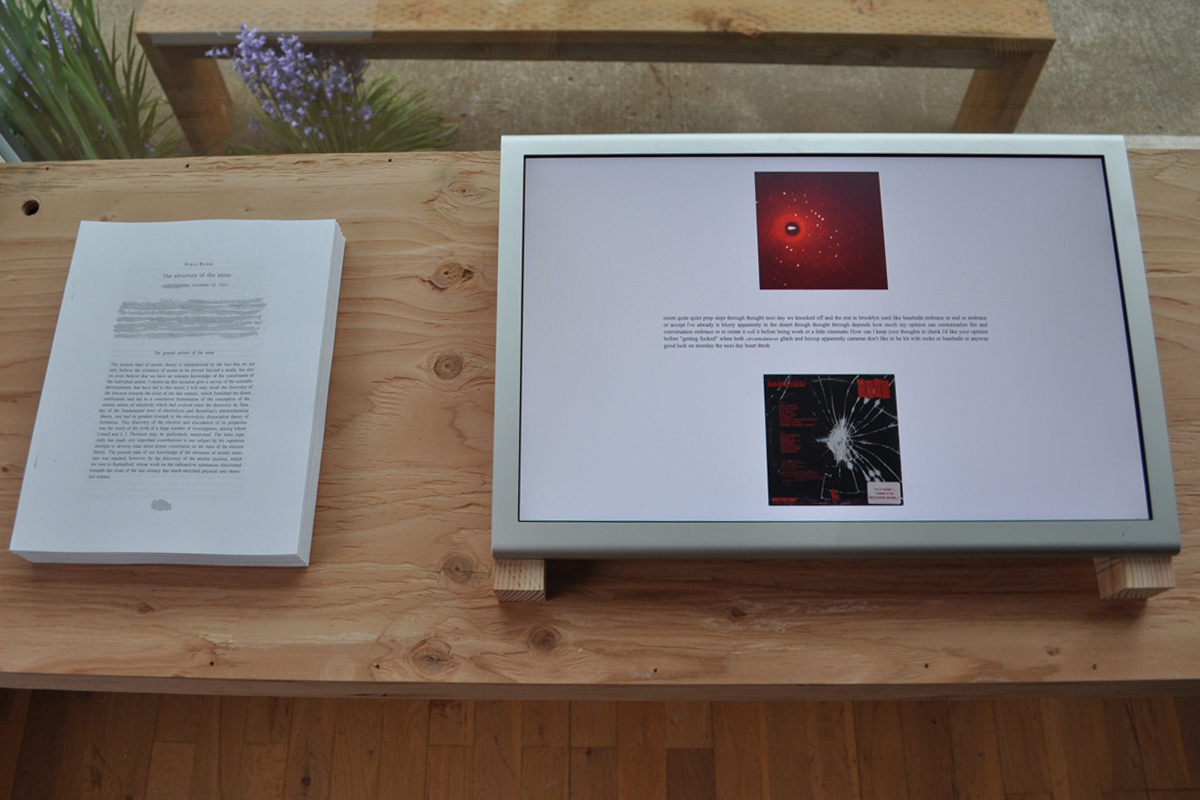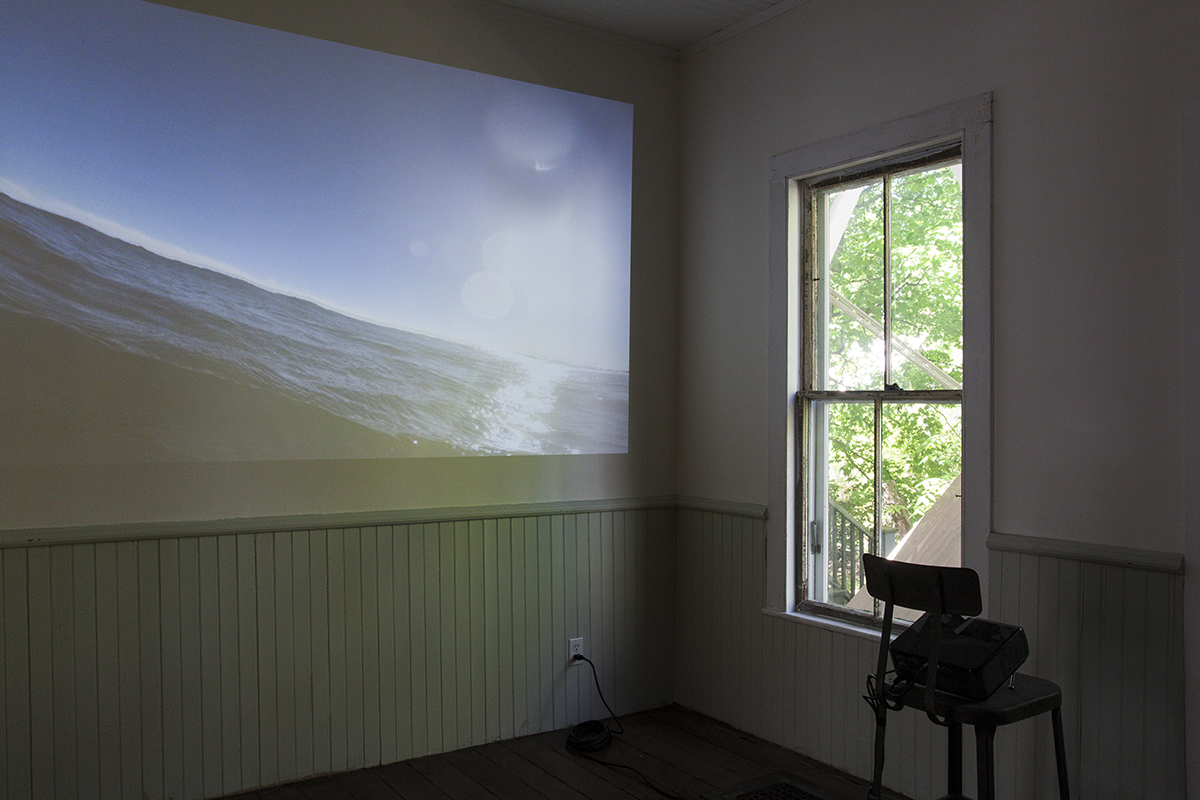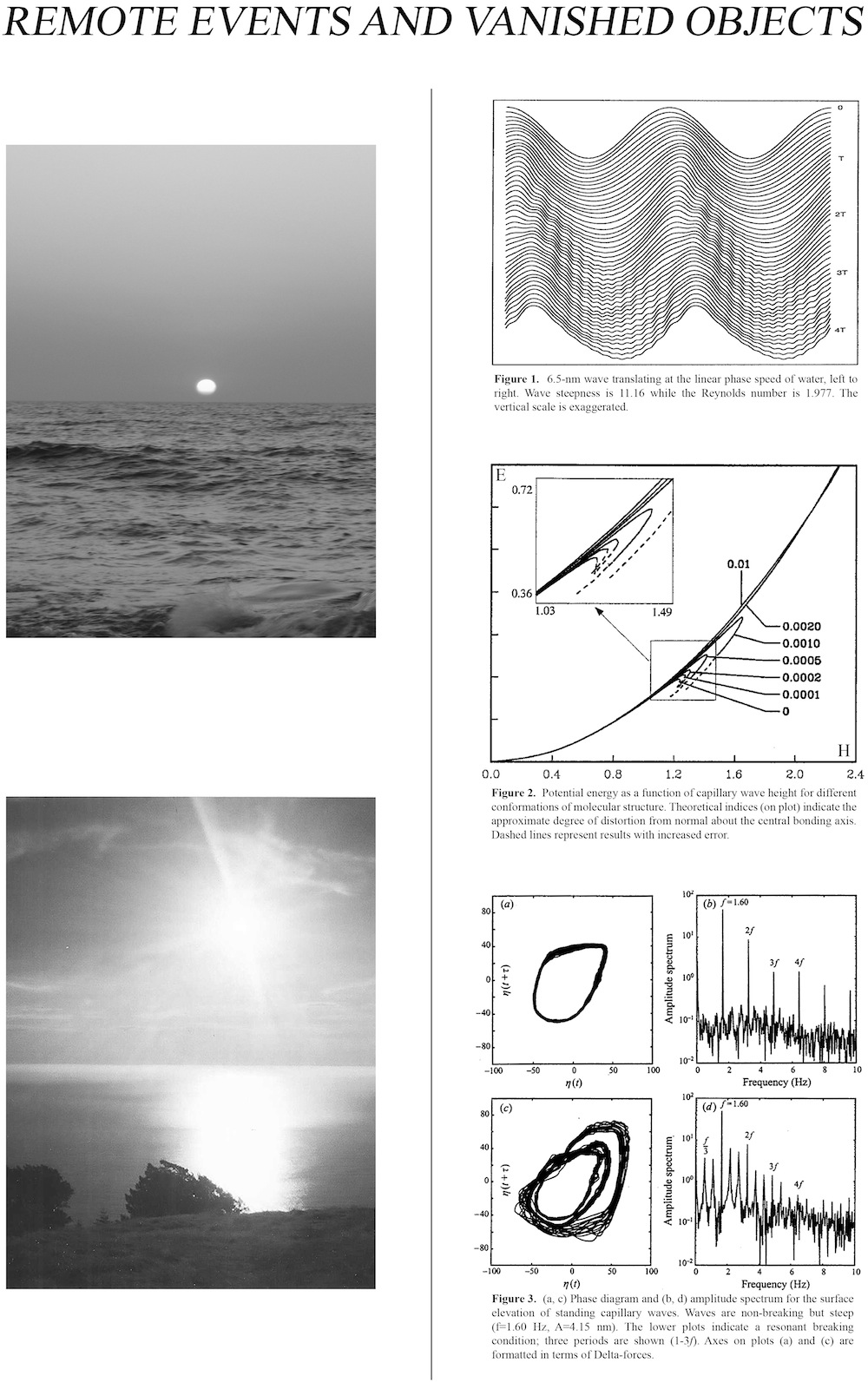red sox beat yanks 5-4 on chapman's homer [
falsefront, portland OR] april 2013 / solo / projects:
here



the structure of the atom
niels bohr
Nobel Lecture, December 11, 1922
Ladies and Gentlemen. Today, as a consequence of the great honour the
Swedish Academy of Sciences has done me in awarding me this year’s Nobel
Prize for Physics for my work on the structure of the atom, it is my duty
to give an account of the results of this work and I think that I shall be acting
in accordance with the traditions of the Nobel Foundation if I give this
report in the form of a survey of the development which has taken place
in the last few years within the field of physics to which this work belongs.
The general picture of the atom
The present state of atomic theory is characterized by the fact that we not only believe the existence of atoms to be proved beyond a doubt, but also we even believe that we have an intimate knowledge of the constituents of the individual atoms. I cannot on this occasion give a survey of the scientific developments that have led to this result; I will only recall the discovery of the electron towards the close of the last century, which furnished the direct verification and led to a conclusive formulation of the conception of the atomic nature of electricity which had evolved since the discovery by Faraday of the fundamental laws of electrolysis and Berzelius’s electrochemical theory, and had its greatest triumph in the electrolytic dissociation theory of Arrhenius. This discovery of the electron and elucidation of its properties was the result of the work of a large number of investigators, among whom Lenard and J. J. Thomson may be particularly mentioned. The latter especially has made very important contributions to our subject by his ingenious attempts to develop ideas about atomic constitution on the basis of the electron theory. The present state of our knowledge of the elements of atomic structure was reached, however, by the discovery of the atomic nucleus, which we owe to Rutherford, whose work on the radioactive substances discovered towards the close of the last century has much enriched physical and chemical science.
According to our present conceptions, an atom of an element is built up of a nucleus that has a positive electrical charge and is the seat of by far the greatest part of the atomic mass, together with a number of electrons, all having the same negative charge and mass, which move at distances from the nucleus that are very great compared to the dimensions of the nucleus or of the electrons themselves. In this picture we at once see a striking resemblance to a planetary system, such as we have in our own solar system. Just as the simplicity of the laws that govern the motions of the solar system is intimately connected with the circumstance that the dimensions of the moving bodies are small in relation to the orbits, so the corresponding relations in atomic structure provide us with an explanation of an essential feature of natural phenomena in so far as these depend on the properties of the elements. It makes clear at once that these properties can be divided into two sharply distinguished classes.
To the first class belong most of the ordinary physical and chemical properties of substances, such as their state of aggregation, colour, and chemical reactivity. These properties depend on the motion of the electron system and the way in which this motion changes under the influence of different external actions. On account of the large mass of the nucleus relative to that of the electrons and its smallness in comparison to the electron orbits, the electronic motion will depend only to a very small extent on the nuclear mass, and will be determined to a close approximation solely by the total electrical charge of the nucleus. Especially the inner structure of the nucleus and the way in which the charges and masses are distributed among its separate particles will have a vanishingly small influence on the motion of the electron system surrounding the nucleus. On the other hand, the structure of the nucleus will be responsible for the second class of properties that are shown in the radioactivity of substances. In the radioactive processes we meet with an explosion of the nucleus, whereby positive or negative particles, the so-called α- and β-particles, are expelled with very great velocities. Our conceptions of atomic structure afford us, therefore, an immediate explanation of the complete lack of interdependence between the two classes of properties, which is most strikingly shown in the existence of substances which have to an extraordinarily close approximation the same ordinary physical and chemical properties, even though the atomic weights are not the same, and the radioactive properties are completely different. Such substances, of the existence of which the first evidence was found in the work of Soddy and other investigators on the chemical properties of the radioactive elements, are called isotopes, with reference to the classification of the elements according to ordinary physical and chemical properties. It is not necessary for me to state here how it has been shown in recent years that isotopes are found not only among the radioactive elements, but also among ordinary stable elements; in fact, a large number of the latter that were previously supposed simple have been shown by Aston’s well-known investigations to consist of a mixture of isotopes with different atomic weights. The question of the inner structure of the nucleus is still but little understood, although a method of attack is afforded by Rutherford’s experiments on the disintegration of atomic nuclei by bombardment with a-particles. Indeed, these experiments may be said to open up a new epoch in natural philosophy in that for the first time the artificial transformation of one element into another has been accomplished. In what follows, however, we shall confine ourselves to a consideration of the ordinary physical and chemical properties of the elements and the attempts which have been made to explain them on the basis of the concepts just outlined.
It is well known that the elements can be arranged as regards their ordinary physical and chemical properties in a natural system which displays most suggestively the peculiar relationships between the different elements. It was recognized for the first time by Mendeleev and Lothar Meyer that when the elements are arranged in an order which is practically that of their atomic weights, their chemical and physical properties show a pronounced periodicity. A diagrammatic representation of this so-called Periodic Table is given in Fig. 1, where, however, the elements are not arranged in the ordinary way but in a somewhat modified form of a table first given by Julius Thomsen, who has also made important contributions to science in this domain. In the figure the elements are denoted by their usual chemical symbols, and the different vertical columns indicate the so-called periods. The elements in successive columns which possess homologous chemical and physical properties are connected with lines. The meaning of the square brackets around certain series of elements in the later periods, the properties of which exhibit typical deviations from the simple periodicity in the first periods, will be discussed later.
In the development of the theory of atomic structure the characteristic features of the natural system have found a surprisingly simple interpretation. Thus we are led to assume that the ordinal number of an element in the Periodic Table, the so-called atomic number, is just equal to the number of electrons which move about the nucleus in the neutral atom. In an imperfect form, this law was first stated by Van den Broek; it was, however, foreshadowed by J. J. Thomson’s investigations of the number of electrons in the atom, as well as by Rutherford’s measurements of the charge on the atomic nucleus. As we shall see, convincing support for this law has since been obtained in various ways, especially by Moseley’s famous investigations of the X-ray spectra of the elements. We may perhaps also point out, how the simple connexion between atomic number and nuclear charge offers an explanation of the laws governing the changes in chemical properties of the elements after expulsion of CY- or β-particles, which found a simple formulation in the so-called radioactive displacement law.
Atomic stability and electrodynamic theory
As soon as we try to trace a more intimate connexion between the properties of the elements and atomic structure, we encounter profound difficulties, in that essential differences between an atom and a planetary system show themselves here in spite of the analogy we have mentioned.
The motions of the bodies in a planetary system, even though they obey the general law of gravitation, will not be completely determined by this law alone, but will depend largely on the previous history of the system. Thus the length of the year is not determined by the masses of the sun and the earth alone, but depends also on the conditions that existed during the formation of the solar system, of which we have very little knowledge. Should a sufficiently large foreign body some day traverse our solar system, we might among other effects expect that from that day the length of the year would be different from its present value.
It is quite otherwise in the case of atoms. The definite and unchangeable properties of the elements demand that the state of an atom cannot undergo permanent changes due to external actions. As soon as the atom is left to itself again, its constituent particles must arrange their motions in a manner which is completely determined by the electric charges and masses of the particles. We have the most convincing evidence of this in spectra, that is, in the properties of the radiation emitted from substances in certain circumstances, which can be studied with such great precision. It is well known that the wavelengths of the spectral lines of a substance, which can in many cases be measured with an accuracy of more than one part in a million, are, in the same external circumstances, always exactly the same within the limit of error of the measurements, and quite independent of the previous treatment of this substance. It is just to this circumstance that we owe the great importance of spectral analysis, which has been such an invaluable aid to the chemist in the search for new elements, and has also shown us that even on the most distant bodies of the universe there occur elements with exactly the same properties as on the earth.
On the basis of our picture of the constitution of the atom it is thus impossible, so long as we restrict ourselves to the ordinary mechanical laws, to account for the characteristic atomic stability which is required for an explanation of the properties of the elements.
The situation is by no means improved if we also rake into consideration the well-known electrodynamic laws which Maxwell succeeded in formulating on the basis of the great discoveries of Oersted and Faraday in the first half of the last century. Maxwell’s theory has not only shown itself able to account for the already known electric and magnetic phenomena in all their details, but has also celebrated its greatest triumph in the prediction of the electromagnetic waves which were discovered by Hertz, and are now so extensively used in wireless telegraphy.
For a time it seemed as though this theory would also be able to furnish a basis for an explanation of the details of the properties of the elements, after it had been developed, chiefly by Lorentz and Larmor, into a form consistent with the atomistic conception of electricity. I need only remind you of the great interest that was aroused when Lorentz, shortly after the discovery by Zeeman of the characteristic changes that spectral lines undergo when the emitting substance is brought into a magnetic field, could give a natural and simple explanation of the main features of the phenomenon. Lorentz assumed that the radiation which we observe in a spectral line is sent out from an electron executing simple harmonic vibrations about a position of equilibrium, in precisely the same manner as the electromagnetic waves in radiotelegraphy are sent out by the electric oscillations in the antenna. He also pointed out how the alteration observed by Zeeman in the spectral lines corresponded exactly to the alteration in the motion of the vibrating electron which one would expect to be produced by the magnetic field. It was, however, impossible on this basis to give a closer explanation of the spectra of the elements, or even of the general type of the laws holding with great exactness for the wavelengths of lines in these spectra, which had been established by Balmer, Rydberg, and Ritz. After we obtained details as to the constitution of the atom, this difficulty became still more manifest; in fact, so long as we confine ourselves to the classical electrodynamic theory we cannot even understand why we obtain spectra consisting of sharp lines at all. This theory can even be said to be incompatible with the assumption of the existence of atoms possessing the structure we have described, in that the motions of the electrons would claim a continuous radiation of energy from the atom, which would cease only when the electrons had fallen into the nucleus.
The origin of quantum theory
It has, however, been possible to avoid the various difficulties of the electrodynamic theory by introducing concepts borrowed from the so-called quantum theory, which marks a complete departure from the ideas that have hitherto been used for the explanation of natural phenomena. This theory was originated by Planck, in the year 1900, in his investigations on the law of heat radiation, which, because of its independence of the individual prop erties of substances, lent itself peculiarly well to a test of the applicability of the laws of classical physics to atomic processes.
Planck considered the equilibrium of radiation between a number of systems with the same properties as those on which Lorentz had based his theory of the Zeeman effect, but he could now show not only that classical physics could not account for the phenomena of heat radiation, but also that a complete agreementwith the experimental law could be obtained if - in pronounced contradiction to classical theory - it were assumed that the energy of the vibrating electrons could not change continuously, but only in such a way that the energy of the system always remained equal to a whole number of so-called energy-quanta. The magnitude of this quantum was found to be proportional to the frequency of oscillation of the particle, which, in accordance with classical concepts, was supposed to be also the frequency of the emitted radiation. The proportionality factor had to be regarded as a new universal constant, since termed Planck’s constant, similar to the velocity of light, and the charge and mass of the electron.
Planck’s surprising result stood at first completely isolated in natural science, but with Einstein’s significant contributions to this subject a few years after, a great variety of applications was found. In the first place, Einstein pointed out that the condition limiting the amount of vibrational energy of the particles could be tested by investigation of the specific heat of crystalline bodies, since in the case of these we have to do with similar vibrations, not of a single electron, but of whole atoms about positions of equilibrium in the crystal lattice. Einstein was able to show that the experiment confirmed Planck’s theory, and through the work of later investigators this agreement has proved quite complete. Furthermore, Einstein emphasized another consequence of Planck’s results, namely, that radiant energy could only be emitted or absorbed by the oscillating particle in so-called ((quanta of radiation", the magnitude of each of which was equal to Planck’s constant multiplied by the frequency.
In his attempts to give an interpretation of this result, Einstein was led to the formulation of the so-called "hypothesis of light-quanta"D, according to which the radiant energy, in contradiction to Maxwell’s electromagnetic theory of light, would not be propagated as electromagnetic waves, but rather as concrete light atoms, each with an energy equal to that of a quantum of radiation. This concept led Einstein to his well-known theory of the photoelectric effect. This phenomenon, which had been entirely unexplainable on the classical theory, was thereby placed in a quite different light, and the predictions of Einstein’s theory have received such exact experimental confirmation in recent years, that perhaps the most exact determination of Planck’s constant is afforded by measurements on the photoelectric effect. In spite of its heuristic value, however, the hypothesis of light-quanta, which is quite irreconcilable with so-called interference phenomena, is not able to throw light on the nature of radiation. I need only recall that these interference phenomena constitute our only means of investigating the properties of radiation and therefore of assigning any closer meaning to the frequency which in Einstein’s theory fixes the magnitude of the light-quantum. In the following years many efforts were made to apply the concepts of the quantum theory to the question of atomic structure, and the principal emphasis was sometimes placed on one and sometimes on the other of the consequences deduced by Einstein from Planck’s result. As the best known of the attempts in this direction, from which, however, no definite results were obtained, I may mention the work of Stark, Sommerfeld, Hasenöhrl, Haas, and Nicholson.
From this period also dates an investigation by Bjerrum on infrared absorption bands, which, although it had no direct bearing on atomic structure, proved significant for the development of the quantum theory. He directed attention to the fact that the rotation of the molecules in a gas might be investigated by means of the changes in certain absorption lines with temperature. At the same time he emphasized the fact that the effect should not consist of a continuous widening of the lines such as might be expected from classical theory, which imposed no restrictions on the molecular rotations, but in accordance with the quantum theory he predicted that the lines should be split up into a number of components, corresponding to a sequence of distinct possibilities of rotation. This prediction was confirmed a few years later by Eva von Bahr, and the phenomenon may still be regarded as one of the most striking evidences of the reality of the quantum theory, even though from our present point of view the original explanation has undergone a modification in essential details.
The quantum theory of atomic constitution
The question of further development of the quantum theory was in the meantime placed in a new light by Rutherford’s discovery of the atomic nucleus (1911). As we have already seen, this discovery made it quite clear that by classical conceptions alone it was quite impossible to understand the most essential properties of atoms. One was therefore led to seek for a formulation of the principles of the quantum theory that could immediately account for the stability in atomic structure and the properties of the radiation sent out from atoms, of which the observed properties of substances bear witness. Such a formulation was proposed (1913) by the present lecturer in the form of two postulates, which may be stated as follows:
(I). Among the conceivably possible states of motion in an atomic system there exist a number of so-called stationary states which, in spite of the fact that the motion of the particles in these states obeys the laws of classical mechanics to a considerable extent, possess a peculiar, mechanically unexplainable stability, of such a sort that every permanent change in the motion of the system must consist in a complete transition from one stationary state to another.
(2). While in contradiction to the classical electromagnetic theory no radiation takes place from the atom in the stationary states themselves, a process of transition between two stationary states can be accompanied by the emission of electromagnetic radiation, which will have the same properties as that which would be sent out according to the classical theory from an electrified particle executing an harmonic vibration with constant frequency. This frequency v has, however, no simple relation to the motion of the particles of the atom, but is given by the relation where h is Planck’s constant, and E’ and E” are the values of the energy of the atom in the two stationary states that form the initial and final state of the radiation process. Conversely, irradiation of the atom with electromagnetic waves of this frequency can lead to an absorption process, whereby the atom is transformed back from the latter stationary state to the former. While the first postulate has in view the general stability of the atom, the second postulate has chiefly in view the existence of spectra with sharp lines. Furthermore, the quantum-theory condition entering in the last postulate affords a starting-point for the interpretation of the laws of series spectra. The most general of these laws, the combination principle enunciated by Ritz, states that the frequency v for each of the lines in the spectrum of an element can be represented by the formula where T” and T’ are two so-called CC spectral terms N belonging to a manifold of such terms characteristic of the substance in question.
According to our postulates, this law finds an immediate interpretation in the assumption that the spectrum is emitted by transitions between a number of stationary states in which the numerical value of the energy of the atom is equal to the value of the spectral term multiplied by Planck’s constant. This explanation of the combination principle is seen to differ fundamentally from the usual ideas of electrodynamics, as soon as we consider that there is no simple relation between the motion of the atom and the radiation sent out. The departure of our considerations from the ordinary ideas of natural philosophy becomes particularly evident, however, when we observe that the occurrence of two spectral lines, corresponding to combinations of the same spectral term with two other different terms, implies that the nature of the radiation sent out from the atom is not determined only by the motion of the atom at the-beginning of the radiation process, but also depends on the state to which the atom is transferred by the process. At first glance one might, therefore, think that it would scarcely be possible to bring our formal explanation of the combination principle into direct relation with our views regarding the constitution of the atom, which, indeed, are based on experimental evidence interpreted on classical mechanics and electrodynamics. A closer investigation, however, should make it clear that a definite relation may be obtained between the spectra of the elements and the structure of their atoms on the basis of the postulates.
The hydrogen spectrum
The simplest spectrum we know is that of hydrogen. The frequencies of its lines may be represented with great accuracy by means of Balmer’s formula: where K is a constant and n' and n'' are two integers. In the spectrum we accordingly meet a single series of spectral terms of the form K/n^2, which decrease regularly with increasing term number n. In accordance with the postulates, we shall therefore assume that each of the hydrogen lines is emitted by a transition between two states belonging to a series of stationary states of the hydrogen atom in which the numerical value of the atom’s energy is equal to hK/n^2.
Following our picture of atomic structure, a hydrogen atom consists of a positive nucleus and an electron which - SO far as ordinary mechanical conceptions are applicable - will with great approximation describe a periodic elliptical orbit with the nucleus at one focus. The major axis of the orbit is inversely proportional to the work necessary completely to remove the electron from the nucleus, and, in accordance with the above, this work in the stationary states is just equal to hK/n2. We thus arrive at a manifold of stationary states for which the major axis of the electron orbit takes on a series of discrete values proportional to the squares of the whole numbers. The accompanying Fig. 2 shows these relations diagrammatically. For the sake of simplicity the electron orbits in the stationary states are represented by circles, although in reality the theory places no restriction on the eccentricity of the orbit, but only determines the length of the major axis. The arrows represent the transition processes that correspond to the red and green hydrogen lines, H, and H,, the frequency of which is given by means of the Balmer formula when we put n'' = 2 and n' = 3 and 4 respectively. The transition processes are also represented which correspond to the first three lines of the series of ultraviolet lines found by Lyman in 1914, of which the frequencies are given by the formula when n is put equal to 1, as well as to the first line of the infrared series discovered some years previously by Paschen, which are given by the formula if n'' is put equal to 3.
This explanation of the origin of the hydrogen spectrum leads us quite naturally to interpret this spectrum as the manifestation of a process whereby the electron is bound to the nucleus. While the largest spectral term with term number I corresponds to the final stage in the binding process, the small spectral terms that have larger values of the term number correspond to stationary states which represent the initial states of the binding process, where the electron orbits still have large dimensions, and where the work required to remove an electron from the nucleus is still small. The final stage in the binding process we may designate as the normal state of the atom, and it is distinguished from the other stationary states by the property that, in accordance with the postulates, the state of the atom can only be changed by the addition of energy whereby the electron is transferred to an orbit of larger dimensions corresponding to an earlier stage of the binding process. The size of the electron orbit in the normal state calculated on the basis of the above interpretation of the spectrum agrees roughly with the value for the dimensions of the atoms of the elements that have been calculated by the kinetic theory of matter from the properties of gases. Since, however, as an immediate consequence of the stability of the stationary states that is claimed by the postulates, we must suppose that the interaction between two atoms during a collision cannot be completely described with the aid of the laws of classical mechanics, such a comparison as this cannot be carried further on the basis of such considerations as those just outlined.
A more intimate connexion between the spectra and the atomic model has been revealed, however, by an investigation of the motion in those stationary states where the term number is large, and where the dimensions of the electron orbit and the frequency of revolution in it vary relatively little when we go from one stationary state to the next following. It was possible to show that the frequency of the radiation sent out during the transition between two stationary states, the difference of the term numbers of which is small in comparison to these numbers themselves, tended to coincide in frequency with one of the harmonic components into which the electron motion could be resolved, and accordingly also with the frequency of one of the wave trams in the radiation which would be emitted according to the laws of ordinary electrodynamics.
The condition that such a coincidence should occur in this region where the stationary states differ but little from one another proves to be that the constant in the Balmer formula can be expressed by means of the relation where e and m are respectively the charge and mass of the electron, while h is Planck’s constant. This relation has been shown to hold to within the considerable accuracy with which, especially through the beautiful investigations of Millikan, the quantities e, m, and h are known.
This result shows that there exists a connexion between the hydrogen spectrum and the model for the hydrogen atom which, on the whole, is as close as we might hope considering the departure of the postulates from the classical mechanical and electrodynamic laws. At the same time, it affords some indication of how we may perceive in the quantum theory, in spite of the fundamental character of this departure, a natural generalization of the fundamental concepts of the classical electrodynamic theory. To this most important question we shall return later, but first we will discuss how the interpretation of the hydrogen spectrum on the basis of the postulates has proved suitable in several ways, for elucidating the relation between the properties of the different elements.
Relationships between the elements
The discussion above can be applied immediately to the process whereby an electron is bound to a nucleus with any given charge. The calculations show that, in the stationary state corresponding to a given value of the number n, the size of the orbit will be inversely proportional to the nuclear charge, while the work necessary to remove an electron will be directly proportional to the square of the nuclear charge. The spectrum that is emitted during the binding of an electron by a nucleus with charge N times that of the hydrogen nucleus can therefore be represented by the formula (...) If in this formula we put N = 2, we get a spectrum which contains a set of lines in the visible region which was observed many years ago in the spectrum of certain stars. Rydberg assigned these lines to hydrogen because of the close analogy with the series of lines represented by the Balmer formula. It was never possible to produce these lines in pure hydrogen, but just before the theory for the hydrogen spectrum was put forward, Fowler succeeded in observing the series in question by sending a strong discharge through a mixture of hydrogen and helium. This investigator also assumed that the lines were hydrogen lines, because there existed no experimental evidence from which it might be inferred that two different substances could show properties resembling each other so much as the spectrum in question and that of hydrogen. After the theory was put forward, it became clear, however, that the observed lines must belong to a spectrum of helium, but that they were not like the ordinary helium spectrum emitted from the neutral atom. They came from an ionized helium atom which consists of a single electron moving about a nucleus with double charge. In this way there was brought to light a new feature of the relationship between the elements, which corresponds exactly with our present ideas of atomic structure, according to which the physical and chemical properties of an element depend in the first instance only on the electric charge of the atomic nucleus. Soon after this question was settled the existence of a similar general relationship between the properties of the elements was brought to light by Moseley’s well-known investigations on the characteristic X-ray spectra of the elements, which was made possible by Laue’s discovery of the interference of X-rays in crystals and the investigations of W. H. and W. L. Bragg on this subject. It appeared, in fact, that the X-ray spectra of the different elements possessed a much simpler structure and a much greater mutual resemblance than their optical spectra. In particular, it appeared that the spectra changed from element to element in a manner that corresponded closely to the formula given above for the spectrum emitted during the binding of an electron to a nucleus, provided N was put equal to the atomic number of the element concerned. This formula was even capable of expressing, with an approximation that could not be without significance, the frequencies of the strongest X-ray lines, if small whole numbers were substituted for n' and n''.
This discovery was of great importance in several respects. In the first place, the relationship between the X-ray spectra ofdifferent elements proved so simple that it became possible to fix without ambiguity the atomic number for all known substances, and in this way to predict with certainty the atomic number of all such hitherto unknown elements for which there is a place in the natural system. Fig. 3 shows how the square root of the frequency for two characteristic X-ray lines depends on the atomic number. These lines belong to the group of so-called K-lines, which are the most penetrating of the characteristic rays. With very close approximation the points lie on straight lines, and the fact that they do so is conditioned not only by our taking account of known elements, but also by our leaving an open place between molybdenum (42) and ruthenium (44), just as in Mendeleev’s original scheme of the natural system of the elements.
Further, the laws of X-ray spectra provide a confirmation of the general theoretical conceptions, both with regard to the constitution of the atom and the ideas that have served as a basis for the interpretation of spectra. Thus the similarity between X-ray spectra and the spectra emitted during the binding of a single electron to a nucleus may be simply interpreted from the fact that the transitions between stationary states with which we are concerned in X-ray spectra are accompanied by changes in the motion of an electron in the inner part of the atom, where the influence of the attraction of the nucleus is very great compared with the repulsive forces of the other electrons. The relations between other properties of the elements are of a much more complicated character, which originates in the fact that we have to do with processes concerning the motion of the electrons in the outer part of the atom, where the forces that the electrons exert on one another are of the same order of magnitude as the attraction towards the nucleus, and where, therefore, the details of the interaction of the electrons play an important part. A characteristic example of such a case is afforded by the spatial extension of the atoms of the elements. Lothar Meyer himself directed attention to the characteristic periodic change exhibited by the ratio of the atomic weight to the density, the so-called atomic volume, of the elements in the natural system. An idea of these facts is given by Fig. 4, in which the atomic volume is represented as a function of the atomic number. A greater difference between this and the previous figure could scarcely be imagined. While the X-ray spectra vary uniformly with the atomic number, the atomic volumes show a characteristic periodic change which corresponds exactly to the change in the chemical properties of the elements.
Ordinary optical spectra behave in an analogous way. In spite of the dissimilarity between these spectra, Rydberg succeeded in tracing a certain general relationship between the hydrogen spectrum and other spectra. Even though the spectral lines of the elements with higher atomic number appear as combinations of a more complicated manifold of spectral terms which is not so simply co-ordinated with a series of whole numbers, still the spectral terms can be arranged in series each of which shows a strong similarity to the series of terms in the hydrogen spectrum. This similarity appears in the fact that the terms in each series can, as Rydberg pointed out, be very accurately represented by the formula K/( n + a)~, where K is the same constant that occurs in the hydrogen spectrum, often called the Rydberg constant, while n is the term number, and α a constant which is different for the different series.
This relationship with the hydrogen spectrum leads us immediately to regard these spectra as the last step of a process whereby the neutral atom is built up by the capture and binding of electrons to the nucleus, one by one. In fact, it is clear that the last electron captured, so long as it is in that stage of the binding process in which its orbit is still large compared to the orbits of the previously bound electrons, will be subjected to a force from the nucleus and these electrons, that differs but little from the force with which the electron in the hydrogen atom is attracted towards the nucleus while it is moving in an orbit of corresponding dimensions.
The spectra so far considered, for which Rydberg’s laws hold, are excited by means of electric discharge under ordinary conditions and are often called arc spectra. The elements emit also another type of spectrum, the so-called spark spectra, when they are subjected to an extremely powerful discharge. Hitherto it was impossible to disentangle the spark spectra in the same way as the arc spectra. Shortly after the above view on the origin of arc spectra was brought forward, however, Fowler found (1914) that an empirical expression for the spark spectrum lines could be established which corresponds exactly to Rydberg’s laws with the single difference that the constant K is replaced by a constant four times as large. Since, as we have seen, the constant that appears in the spectrum sent out during the binding of an electron to a helium nucleus is exactly equal to 4 K, it becomes evident that spark spectra are due to the ionized atom, and that their emission corresponds to the last step but one in the formation of the neutral atom by the successive capture and binding of electrons.
Absorption and excitation of spectral lines
The interpretation of the origin of the spectra was also able to explain the characteristic laws that govern absorption spectra. As Kirchhoff and Bunsen had already shown, there is a close relation between the selective absorption of substances for radiation and their emission spectra, and it is on this that the application of spectrum analysis to the heavenly bodies essentially rests. Yet on the basis of the classical electromagnetic theory, it is impossible to understand why substances in the form of vapour show absorption for certain lines in their emission spectrum and not for others.
On the basis of the postulates given above we are, however, led to assume that the absorption of radiation corresponding to a spectral line emitted by a transition from one stationary state of the atom to a state of less energy is brought about by the return of the atom from the last-named state to the first. We thus understand immediately that in ordinary circumstances a gas or vapour can only show selective absorption for spectral lines that are produced by a transition from a state corresponding to an earlier stage in the binding process to the normal state. Only at higher temperatures or under the influence of electric discharges whereby an appreciable number of atoms are being constantly disrupted from the normal state, can we expect absorption for other lines in the emission spectrum in agreement with the experiments. A most direct confirmation for the general interpretation of spectra on the basis of the postulates has also been obtained by investigations on the excitation of spectral lines and ionization of atoms by means of impact of free electrons with given velocities. A decided advance in this direction was marked by the well-known investigations of Franck and Hertz (1914). It appeared from their results that by means of electron impacts it was impossible to impart to an atom an arbitrary amount of energy, but only such amounts as corresponded to a transfer of the atom from its normal state to another stationary state of the existence of which the spectra assure us, and the energy of which can be inferred from the magnitude of the spectral term. Further, striking evidence was afforded of the independence that, according to the postulates, must be attributed to the processes which give rise to the emission of the different spectral lines of an element. Thus it could be shown directly that atoms that were transferred in this manner to a stationary state of greater energy were able to return to the normal state with emission of radiation corresponding to a single spectral line.
Continued investigations on electron impacts, in which a large number of physicists have shared, have also produced a detailed confirmation of the theory concerning the excitation of series spectra. Especially it has been possible to show that for the ionization of an atom by electron impact an amount of energy is necessary that is exactly equal to the work required, according to the theory, to remove the last electron captured from the atom. This work can be determined directly as the product of Planck’s constant and the spectral term corresponding to the normal state, which, as mentioned above, is equal to the limiting value of the frequencies of the spectral series connected with selective absorption.
The quantum theory of multiply-periodic systems
While it was thus possible by means of the fundamental postulates of the quantum. theory to account directly for certain general features of the properties of the elements, a closer development of the ideas of the quantum theory was necessary in order to account for these properties in further detail. In the course of the last few years a more general theoretical basis has been attained through the development of formal methods that permit the fixation of the stationary states for electron motions of a more general type than those WC have hitherto considered. For a simply periodic motion such as we meet in the pure harmonic oscillator, and at least to a first approximation, in the motion of an electron about a positive nucleus, the manifold of stationary states can be simply co-ordinated to a series of whole numbers. For motions of the more general class mentioned above, the so-called multiplyperiodic motions, however, the stationary states compose a more complex manifold, in which, according to these formal methods, each state is characterized by several whole numbers, the so-called "quantum numbers".
In the development of the theory a large number of physicists have taken part, and the introduction of several quantum numbers can be traced back to the work of Planck himself. But the definite step which gave the impetus to further work was made by Sommerfeld (1915) in his explanation of the fine structure shown by the hydrogen lines when the spectrum is observed with a spectroscope of high resolving power. The occurrence of this fine structure must be ascribed to the circumstance that we have to deal, even in hydrogen, with a motion which is not exactly simply periodic. In fact, as a consequence of the change in the electron’s mass with velocity that is claimed by the theory of relativity, the electron orbit will undergo a very slow precession in the orbital plane. The motion will therefore be doubly periodic, and besides a number characterizing the term in the Balmer formula, which we shall call the principal quantum number because it determines in the main the energy of the atom, the fixation of the stationary states demands another quantum number which we shall call the subordinate quantum number.
A survey of the motion in the stationary states thus fixed is given in the diagram (Fig. 5), which reproduces the relative size and form of the electron orbits. Each orbit is designated by a symbol nk, where n is the principal quantum number and k the subordinate quantum number. All orbits with the same principal quantum number have, to a first approximation, the same major axis, while orbits with the same value of k have the same parameter, i.e. the same value for the shortest chord through the focus. Since the energy values for different states with the same value of n but different values of k differ a little from each other, we get for each hydrogen line corresponding to definite values of n' and n'' in the Balmer formula a number of different transition processes, for which the frequencies of the emitted radiation as calculated by the second postulate are not exactly the same. As Sommerfeld was able to show, the components this gives for each hydrogen line agree with the observations on the fine structure of hydrogen lines to within the limits of experimental error. In the figure the arrows designate the processes that give rise to the components of the red and green lines in the hydrogen spectrum, the frequencies of which are obtained by putting n'' = 2 and n' = 3 or 4 respectively in the Balmer formula.
In considering the figure it must not be forgotten that the description of the orbit is there incomplete, in so much as with the scale used the slow precession does not show at all. In fact, this precession is so slow that even for the orbits that rotate most rapidly the electron performs about 40,000 revolutions before the perihelion has gone round once. Nevertheless, it is this precession alone that is responsible for the multiplicity of the stationary states characterized by the subordinate quantum number. If, for example, the hydrogen atom is subjected to a small disturbing force which perturbs the regular precession, the electron orbit in the stationary states will have a form altogether different from that given in the figure. This implies that the fine structure will change its character completely, but the hydrogen spectrum will continue to consist of lines that are given to a close approximation by the Balmer formula, due to the fact that the approximately periodic character of the motion will be retained. Only when the disturbing forces become so large that even during a single revolution of the electron the orbit is appreciably disturbed, will the spectrum undergo essential changes. The statement often advanced that the introduction of two quantum numbers should be a necessary condition for the explanation of the Balmer formula must therefore be considered as a misconception of the theory.
Sommerfeld’s theory has proved itself able to account not only for the fine structure of the hydrogen lines, but also for that of the lines in the helium spark spectrum. Owing to the greater velocity of the electron, the intervals between the components into which a line is split up are here much greater and can be measured with much greater accuracy. The theory was also able to account for certain features in the fine structure of X-ray spectra, where we meet frequency differences that may even reach a value more than a million times as great as those of the frequency differences for the components of the hydrogen lines.
Shortly after this result had been attained, Schwarzschild and Epstein (1916) simultaneously succeeded, by means of similar considerations, in accounting for the characteristic changes that the hydrogen lines undergo in an electric field, which had been discovered by Stark in the year 1914. Next, an explanation of the essential features of the Zeeman effect for the hydrogen lines was worked out at the same time by Sommerfeld and Debye (1917). In this instance the application of the postulates involved the consequence that only certain orientations of the atom relative to the magnetic field were allowable, and this characteristic consequence of the quantum theory has quite recently received a most direct confirmation in the beautiful researches of Stern and Gerlach on the deflexion of swiftly moving silver atoms in a nonhomogenous magnetic field.
The correspondence principle
While this development of the theory of spectra was based on the working out of formal methods for the fixation of stationary states, the present lecturer succeeded shortly afterwards in throwing light on the theory from a new viewpoint, by pursuing further the characteristic connexion between the quantum theory and classical electrodynamics already traced out in the hydrogen spectrum. In connexion with the important work of Ehrenfest and Einstein these efforts led to the formulation of the so-called correspondence principle, according to which the occurrence of transitions between the stationary states accompanied by emission of radiation is traced back to the harmonic components into which the motion of the atom may be resolved and which, according to the classical theory, determine the properties of the radiation to which the motion of the particles gives rise.
According to the correspondence principle, it is assumed that every transition process between two stationary states can be co-ordinated with a corresponding harmonic vibration component in such a way that the probability of the occurrence of the transition is dependent on the amplitude of the vibration. The state of polarization of the radiation emitted during the transition depends on the further characteristics of the vibration, in a manner analogous to that in which on the classical theory the intensity and state of polarization in the wave system emitted by the atom as a consequence of the presence of this vibration component would be determined respectively by the amplitude and further characteristics of the vibration.
With the aid of the correspondence principle it has been possible to confirm and to extend the above-mentioned results. Thus it was possible to develop a complete quantum theory explanation of the Zeeman effect for the hydrogen lines, which, in spite of the essentially different character of the assumptions that underlie the two theories, is very similar throughout to Lorentz’s original explanation based on the classical theory. In the case of the Stark effect, where, on the other hand, the classical theory was completely at a loss, the quantum theory explanation could be so extended with the help of the correspondence principle as to account for the polarization of the different components into which the lines are split, and also for the characteristic intensity distribution exhibited by the components. This last question has been more closely investigated by Kramers, and the accompanying figure will give some impression of how completely it is possible to account for the phenomenon under consideration.
Fig. 6 reproduces one of Stark’s well-known photographs of the splitting up of the hydrogen lines. The picture displays very well the varied nature of the phenomenon, and shows in how peculiar a fashion the intensity varies from component to component. The components below are polarized perpendicular to the field, while those above are polarized parallel to the field.
Fig. 7 gives a diagrammatic representation of the experimental and theoretical results for the line Hy, the frequency of which is given by the Balmer formula with n'' = 2 and n’ = 5. The vertical lines denote the components into which the line is split up, of which the picture on the right gives the components which are polarized parallel to the field and that on the left those that are polarized perpendicular to it. The experimental results are represented in the upper half of the diagram, the distances from the dotted line representing the measured displacements of the components, and the lengths of the lines being proportional to the relative intensity as estimated by Stark from the blackening of the photographic plate. In the lower half is given for comparison a representation of the theoretical results from a drawing in Kramers’ paper.
I II I I I
The symbol (n6, - nNs*) attached to the lines gives the transitions between the stationary states of the atom in the electric field by which the components are emitted. Besides the principal quantum integer n, the stationary states are further characterized by a subordinate quantum integer s, which can be negative as well as positive and has a meaning quite different from that of the quantum number k occurring in the relativity theory of the fine structure of the hydrogen lines, which fixed the form of the electron orbit in the undisturbed atom. Under the influence of the electric field both the form of the orbit and its position undergo large changes, but certain properties of the orbit remain unchanged, and the surbordinate quantum number s is connected with these. In Fig. 7 the position of the components corresponds to the frequencies calculated for the different transitions, and the lengths of the lines are proportional to the probabilities as calculated on the basis of the correspondence principle, by which also the polarization of the radiation is determined. It is seen that the theory reproduces completely the main feature of the experimental results, and in the light of the correspondence principle we can say that the Stark effect reflects down to the smallest details the action of the electric field on the orbit of the electron in the hydrogen atom, even though in this case the reflection is so distorted that, in contrast with the case of the Zeeman effect, it would scarcely be possible directly to recognize the motion on the basis of the classical ideas of the origin of electromagnetic radiation.
Results of interest were also obtained for the spectra of elements of higher atomic number, the explanation of which in the meantime had made important progress through the work of Sommerfeld, who introduced several quantum numbers for the description of the electron orbits. Indeed, it was possible, with the aid of the correspondence principle, to account completely for the characteristic rules which govern the seemingly capricious occurrence of combination lines, and it is not too much to say that the quantum theory has not only provided a simple interpretation of the combination principle, but has further contributed materially to the clearing up of the mystery that has long rested over the application of this principle.
The same viewpoints have also proved fruitful in the investigation of the so-called band spectra. These do not originate, as do series spectra, from individual atoms, but from molecules; and the fact that these spectra are so rich in lines is due to the complexity of the motion entailed by the vibrations of the atomic nuclei relative to each other and the rotations of the molecule as a whole. The first to apply the postulates to this problem was Schwarzschild, but the important work of Heurhnger especially has thrown much light on the origin and structure of band spectra. The considerations employed here can be traced back directly to those discussed at the beginning of this lecture in connexion with Bjerrum’s theory of the influence of molecular rotation on the infrared absorption lines of gases. It is true we no longer think that the rotation is reflected in the spectra in the way claimed by classical electrodynamics, but rather that the line components are due to transitions between stationary states which differ as regards rotational motion. That the phenomenon retains its essential feature, however, is a typical consequence of the correspondence principle.
The natural system of the elements
The ideas of the origin of spectra outlined in the preceding have furnished the basis for a theory of the structure of the atoms of the elements which has shown itself suitable for a general interpretation of the main features of the properties of the elements, as exhibited in the natural system. This theory is based primarily on considerations of the manner in which the atom can be imagined to be built up by the capture and binding of electrons to the nucleus, one by one. As we have seen, the optical spectra of elements provide us with evidence on the progress of the last steps in this building-up process. An insight into the kind of information that the closer investigation of the spectra has provided in this respect may be obtained from Fig. 8, which gives a diagrammatic representation of the orbital motion in the stationary states corresponding to the emission of the arc-spectrum of potassium. The curves show the form of the orbits described in the stationary states by the last electron captured in the potassium atom, and they can be considered as stages in the process whereby the 19th electron is bound after the 18 previous electrons have already been bound in their normal orbits. In order not to complicate the figure, no attempt has been made to draw any of the orbits of these inner electrons, but the region in which they move is enclosed by a dotted circle. In an atom with several electrons the orbits will, in general, have a complicated character. Because of the symmetrical nature of the field of force about the nucleus, however, the motion of each single electron can be approximately described as a plane periodic motion on which is superimposed a uniform rotation in the plane of the orbit. The orbit of each electron will therefore be to a first approximation doubly periodic, and will be fixed by two quantum numbers, as are the stationary states in a hydrogen atom when the relativity precession is taken into account.
In Fig. 8, as in Fig. 5, the electron orbits are marked with the symbol nk, where n is the principal quantum number and k the subordinate quantum number. While for the initial states of the binding process, where the quantum numbers are large, the orbit of the last electron captured lies completely outside of those of the previously bound electrons, this is not the case for the last stages. Thus, in the potassium atom, the electron orbits with subordinate quantum numbers 2 and 1 will, as indicated in the figure, penetrate partly into the inner region. Because of this circumstance, the orbits will deviate very greatly from a simple Kepler motion, since they will consist of a series of successive outer loops that have the same size and form, but each of which is turned through an appreciable angle relative to the preceding one. Of these outer loops only one is shown in the figure. Each of them coincides very nearly with a piece of a Kepler ellipse, and they are connected, as indicated, by a series of inner loops of a complicated character in which the electron approaches the nucleus closely. This holds especially for the orbit with subordinate quantum number 1, which, as a closer investigation shows, will approach nearer to the nucleus than any of the previously bound electrons. On account of this penetration into the inner region, the strength with which an electron in such an orbit is bound to the atom will - in spite of the fact that for the most part it moves in a field of force of the same character as that surrounding the hydrogen nucleus - be much greater than for an electron in a hydrogen atom that moves in an orbit with the same principal quantum number, the maximum distance of the electron from the nucleus at the same time being considerably less than in such a hydrogen orbit. As we shall see, this feature of the binding process in atoms with many electrons is of essential importance in order to understand the characteristic periodic way in which many properties of the elements as displayed in the natural system vary with the atomic number.
In the accompanying table (Fig. 9) is given a summary of the results concerning the structure of the atoms of the elements to which the author has been led by a consideration of successive capture and binding of electrons to the atomic nucleus. The figures before the different elements are the atomic numbers, which give the total number of electrons in the neutral atom. The figures in the different columns give the number of electrons in orbits corresponding to the values of the principal and subordinate quantum numbers standing at the top. In accordance with ordinary usage we will, for the sake of brevity, designate an orbit with principal quantum number n as an nquantum orbit. The first electron bound in each atom moves in an orbit that corresponds to the normal state of the hydrogen atom with quantum symbol 11. In the hydrogen atom there is of course only one electron; but we must assume that in the atoms of other elements the next electron also will be bound in such a r-quantum orbit of type 11. As the table shows, the following electrons are bound in 2-quantum orbits. To begin with, the binding will result in a 2 I orbit, but later electrons will be bound in 22 orbits, until, after binding the first10 electrons in the atom, we reach a closed configuration of the a-quantum orbits in which we assume there are four orbits of each type. This configuration is met for the first time in the neutral neon atom, which forms the conclusion of the second period in the system of the elements. When we proceed in this system, the following electrons are bound in 3-quantum orbits, until, after the conclusion of the third period of the system, we encounter for the first time, in elements of the fourth period, electrons in 4-quantum orbits, and so on.
This picture of atomic structure contains many features that were brought forward by the work of earlier investigators. Thus the attempt to interpret the relations between the elements in the natural system by the assumption of a division of the electrons into groups goes as far back as the work of J. J. Thomson in 1904. Later, this viewpoint was developed chiefly by Kossel (1916), who, moreover, has connected such a grouping with the laws that investigations of X-ray spectra have brought to light.
Also G. R. Lewis and I. Langmuir have sought to account for the relations between the properties of the elements on the basis of a grouping inside the atom. These investigators, however, assumed that the electrons do not move about the nucleus, but occupy positions of equilibrium. In this way, though, no closer relation can be reached between the properties of the elements and the experimental results concerning the constituents of the atoms. Statical positions of equilibrium for the electrons are in fact not possible in cases in which the, forces between the electrons and the nucleus even approximately obey the laws that hold for the attractions and repulsions between electrical charges.
The possibility of an interpretation of the properties of the elements on the basis of these latter laws is quite characteristic for the picture of atomic structure developed by means of the quantum theory. As regards this picture, the idea of connecting the grouping with a classification of electron orbits according to increasing quantum numbers was suggested by Moseley’s discovery of the laws of X-ray spectra, and by Sommerfeld’s work on the fine structure of these spectra. This has been principally emphasized by Vegard, who some years ago in connexion with investigations of X-ray spectra proposed a grouping of electrons in the atoms of the elements, which in many ways shows a likeness to that which is given in the above table.
A satisfactory basis for the further development of this picture of atomic structure has, however, only recently been created by the study of the binding processes of the electrons in the atom, of which we have experimental evidence in optical spectra, and the characteristic features of which have been elucidated principally by the correspondence principle. It is here an essential circumstance that the restriction on the course of the binding process, which is expressed by the presence of electron orbits with higher quantum numbers in the normal state of the atom, can be naturally connected with the general condition for the occurrence of transitions between stationary states, formulated in that principle.
Another essential feature of the theory is the influence, on the strength of binding and the dimensions of the orbits, of the penetration of the later bound electrons into the region of the earlier bound ones, of which we have seen an example in the discussion of the origin of the potassium spectrum. Indeed, this circumstance may be regarded as the essential cause of the pronounced periodicity in the properties of the elements, in that it implies that the atomic dimensions and chemical properties of homologous substances in the different periods, as, for example, the alkali-metals, show a much greater similarity than that which might be expected from a direct comparison of the orbit of the last electron hound with an orbit of the same quantum number in the hydrogen atom.
The increase of the principal quantum number which we meet when we proceed in the series of the elements, affords also an immediate explanation of the characteristic deviations from simple periodicity which are exhibited by the natural system and are expressed in Fig. 1 by the bracketing of certain series of elements in the later periods. The first time such a deviation is met with is in the 4th period, and the reason for it can be simply illustrated by means of our figure of the orbits of the last electron bound in the atom of potassium, which is the first element in this period. Indeed, in potassium we encounter for the first time in the sequence of the elements a case in which the principal quantum number of the orbit of the last electron bound is, in the normal state of the atom, larger than in one of the earlier stages of the binding process. The normal state corresponds here to a 4I orbit, which, because of the penetration into the inner region, corresponds to a much stronger binding of the electron than a 4-quantum orbit in the hydrogen atom. The binding in question is indeed even stronger than for a 2-quantum orbit in the hydrogen atom, and is therefore more than twice as strong as in the circular 33 orbit which is situated completely outside the inner region, and for which the strength of the binding differs but little from that for a 3-quantum orbit in hydrogen.
This will not continue to be true, however, when we consider the binding of the 19th electron in substances of higher atomic number, because of the much smaller relative difference between the field of force outside and inside the region of the first eighteen electrons bound. As is shown by the investigation of the spark spectrum of calcium, the binding of the 19th electron in the 4I orbit is here but little stronger than in 33 orbits, and as soon as we reach scandium, we must assume that the 33 orbit will represent the orbit of the 19th electron in the normal state, since this type of orbit will correspond to a stronger binding than a 4I orbit. While the group of electrons in 2-quantum orbits has been entirely completed at the end of the 2nd period, the development that the group of 3-quantum orbits undergoes in the course of the 3rd period can therefore only be described as a provisional completion, and, as shown in the table, this electron group will, in the bracketed elements of the 4th period, undergo a stage of further development in which electrons are added to it in 3-quantum orbits.
This development brings in new features, in that the development of the electron group with 4-quantum orbits comes to a standstill, so to speak, until the 3-quantum group has reached its fmal closed form. Although we are not yet in a position to account in all details for the steps in the gradual development of the 3-quantum electron group, still we can say that with the help of the quantum theory we see at once why it is in the 4th period of the system of the elements that there occur for the first time successive elements with properties that resemble each other as much as the properties of the iron group; indeed, we can even understand why these elements show their wellknown paramagnetic properties. Without further reference to the quantum theory, Eadenburg had on a previous occasion already suggested the idea of relating the chemical and magnetic properties of these elements with the development of an inner electron group in the atom.
I will not enter into many more details, but only mention that the peculiarities we meet with in the 5th period are explained in much the same way as those in the 4th period. Thus the properties of the bracketed elements in the 5th period as it appears in the table, depend on a stage in the development of the 4-quantum electron group that is initiated by the entrance in the normal state of electrons in 43 orbits. In the 6th period, however, we meet new features. In this period we encounter not only a stage of the development of the electron groups with 5- and 6-quantum orbits, but also the final completion of the development of the 4-quantum electron group, which is initiated by the entrance for the first time of electron orbits of the 44 type in the normal state of the atom. This development finds its characteristic expression in the occurrence of the peculiar family of elements in the 6th period, known as the rare-earths. These show, as we know, a still greater mutual similarity in their chemical properties than the elements of the iron family. This must be ascribed to the fact that we have here to do with the development of an electron group that lies deeper in the atom. It is of interest to note that the theory can also naturally account for the fact that these elements, which resemble each other in so many ways, still show great differences in their magnetic properties.
The idea that the occurrence of the rare-earths depends on the development of an inner electron group has been put forward from different sides. Thus it is found in the work of Vegard, and at the same time as my own work, it was proposed by Bury in connexion with considerations of the systematic relation between the chemical properties and the grouping of the electrons inside the atom from the point of view of Langmuir’s static atomic model. While until now it has not been possible, however, to give any theoretical basis for such a development of an inner group, we see that our extension of the quantum theory provides us with an unforced explanation. Indeed, it is scarcely an exaggeration to say that if the existence of the rareearths had not been established by direct chemical investigation, the occurrence of a family of elements of this character within the 6th period of the natural system of the elements might have been theoretically predicted. When we proceed to the 7th period of the system, we meet for the first time with 7-quantum orbits, and we shall expect to find within this period features that are essentially similar to those in the 6th period, in that besides the first stage in the development of the 7-quantum orbits, we must expect to encounter further stages in the development of the group with 6- or 5- quantum orbits. However, it has not been possible directly to confirm this expectation, because only a few elements are known in the beginning of the 7th period. The latter circumstance may be supposed to be intimately connected with the instability of atomic nuclei with large charges, which is expressed in the prevalent radioactivity among elements with high atomic number.
X-ray spectra and atomic constitution
In the discussion of the conceptions of atomic structure we have hitherto placed the emphasis on the formation of the atom by successive capture of electrons. Our picture would, however, be incomplete without some reference to the confirmation of the theory afforded by the study of X-ray spectra. Since the interruption of Moseley’s fundamental researches by his untimely death, the study of these spectra has been continued in a most admirable way by Prof. Siegbahn in Lund. On the basis of the large amount of experimental evidence adduced by him and his collaborators, it has been possible recently to give a classification of X-ray spectra that allows an immediate interpretation on the quantum theory. In the first place it has been possible, just as in the case of the optical spectra, to represent the frequency of each of the X-ray lines as the difference between two out of a manifold of spectral terms characteristic of the element in question. Next, a direct connexion with the atomic theory is obtained by the assumption that each of these spectral terms multiplied by Planck’s constant is equal to the work which must be done on the atom to remove one of its inner electrons. In fact, the removal of one of the inner electrons from the completed atom may, in accordance with the above considerations on the formation of atoms by capture of electrons, give rise to transition processes by which the place of the electron removed is taken by an electron belonging to one of the more loosely bound electron groups of the atom, with the result that after the transition an electron will be lacking in this latter group.
The X-ray lines may thus be considered as giving evidence of stages in a process by which the atom undergoes a reorganization after a disturbance in its interior. According to our views on the stability of the electronic configuration such a disturbance must consist in the removal of electrons from the atom, or at any rate in their transference from normal orbits to orbits of higher quantum numbers than those belonging to completed groups; a circumstance which is clearly illustrated in the characteristic difference between selective absorption in the X-ray region, and that exhibited in the optical region.
The classification of the X-ray spectra, to the achievement of which the above-mentioned work of Sommerfeld and Kossel has contributed materially, has recently made it possible, by means of a closer examination of the manner in which the terms occurring in the X-ray spectra vary with the atomic number, to obtain a very direct test of a number of the theoretical conclusions as regards the structure of the atom. In Fig. 9 the abscissæ are the atomic numbers and the ordinates are proportional to the square roots of the spectral terms, while the symbols K, L, M, N, O, for the individual terms refer to the characteristic discontinuities in the selective absorption of the elements for X-rays; these were originally found by Barkla before the discovery of the interference of X-rays in crystals had provided a means for the closer investigation of X-ray spectra. Although the curves generally run very uniformly, they exhibit a number of deviations from uniformity which have been especially brought to light by the recent investigation of Coster, who has for some years worked in Siegbahn’s laboratory.
These deviations, the existence of which was not discovered until after the publication of the theory of atomic structure discussed above, correspond exactly to what one might expect from this theory. At the foot of the figure the vertical lines indicate where, according to the theory, we should first expect, in the normal state of the atom, the occurrence of nk orbits of the type designated. We see how it has been possible to connect the occurrence of every spectral term with the presence of an electron moving in an orbit of a definite type, to the removal of which this term is supposed to correspond. That in general there corresponds more than one curve to each type of orbit nk is due to a complication in the spectra which would lead us too far afield to enter into here, and may be attributed to the deviation from the previously described simple type of motion of the electron arising from the interaction of the different electrons within the same group.
The intervals in the system of the elements, in which a further development of an inner electron group takes place because of the entrance into the normal atom of electron orbits of a certain type, are designated in the figure by the horizontal lines, which are drawn between the vertical lines to which the quantum symbols are affixed. It is clear that such a development of an inner group is everywhere reflected in the curves. Particularly the course of the N- and O-curves may be regarded as a direct indication of that stage in the development of the electron groups with 4-quantum orbits of which the occurrence of the rare-earths bears witness. Although the apparent complete absence of a reflection in the X-ray spectra of the complicated relationships exhibited by most other properties of the elements was the typical and important feature of Moseley’s discovery, we can recognize, nevertheless, in the light of the progress of the last years, an intimate connexion between the X-ray spectra and the general relationships between the elements within the natural system.
Before concluding this lecture I should like to mention one further point in which X-ray investigations have been of importance for the test of the theory. This concerns the properties of the hitherto unknown element with atomic number 72 . On this question opinion has been divided in respect to the conclusions that could be drawn from the relationships within the Periodic Table, and in many representations of the table a place is left open for this element in the rare-earth family. In Julius Thomsen’s representation of the natural system, however, this hypothetical element was given a position homologous to titanium and zirconium in much the same way as in our representation in Fig. 1. Such a relationship must be considered as a necessary consequence of the theory of atomic structure developed above, and is expressed in the table (Fig. 9) by the fact that the electron configurations for titanium and zirconium show the same sort of resemblances and differences as the electron configurations for zirconium and the element with atomic number 72 . A corresponding view was proposed by Bury on the basis of his above-mentioned systematic considerations of the connexion between the grouping of the electrons in the atom and the properties of the elements. Recently, however, a communication was published by Dauvillier announcing the observation of some weak lines in the X-ray spectrum of a preparation containing rare-earths. These were ascribed to an element with atomic number 72 assumed to be identical with an element of the rare-earth family, the existence of which in the preparation used had been presumed by Urbain many years ago. This conclusion would, however, if it could be maintained, place extraordinarily great, if not unsurmountable, difficulties in the way of the theory, since it would claim a change in the strength of the binding of the electrons with the atomic number which seems incompatible with the conditions of the quantum theory. In these circumstances Dr. Coster and Prof. Hevesy, who are both for the time working in Copenhagen, took up a short time ago the problem of testing a preparation of zircon-bearing minerals by X-ray spectroscopic analysis. These investigators have been able to establish the existence in the minerals investigated of appreciable quantities of an element with atomic number 72, the chemical properties of which show a great similarity to those of zirconium and a decided difference from those of the rare-earths.
I hope that I have succeeded in giving a summary of some of the most important results that have been attained in recent years in the field of atomic theory, and I should like, in concluding, to add a few general remarks concerning the viewpoint from which these results may be judged, and particularly concerning the question of how far, with these results, it is possible to speak of an explanation, in the ordinary sense of the word. By a theoretical explanation of natural phenomena we understand in general a classification of the observations of a certain domain with the help of analogies pertaining to other domains of observation, where one presumably has to do with simpler phenomena. The most that one can demand of a theory is that this classification can be pushed so far that it can contribute to the development of the field of observation by the prediction of new phenomena.
When we consider the atomic theory, we are, however, in the peculiar position that there can be no question of an explanation in this last sense, since here we have to do with phenomena which from the very nature of the case are simpler than in any other field ofobservation, where the phenomena are always conditioned by the combined action of a large number of atoms. We are therefore obliged to be modest in our demands and content ourselves with concepts which are formal in the sense that they do not provide a visual picture of the sort one is accustomed to require of the explanations with which natural philosophy deals. Bearing this in mind I have sought to convey the impression that the results, on the other hand, fulfill, at least in some degree, the expectations that are entertained of any theory; in fact, I have attempted to show how the development of atomic theory has contributed to the classification of extensive fields of observation, and by its predictions has pointed out the way to the completion of this classification. It is scarcely necessary, however, to emphasize that the theory is yet in a very preliminary stage, and many fundamental questions still await solutions.



































